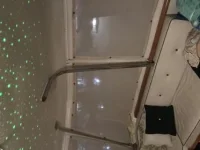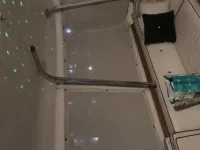mgernes
Active member
- Joined
- Apr 27, 2005
- Messages
- 88
- Status
- OWNER - I own a Hatteras Yacht
- Hatteras Model
- 53' MOTOR YACHT (1969 - 1988)
After years of trying to improve my current crane mechanism on our 1973 53my, including rebuilding the crane itself, adding a pulley system to move my Amanzi tender( a Mercury Product) on and off the chalks on the top of the flybridge, I have finally decided to have Florida Bow-Thrusters replace my existing swim platform with a hydraulic lift. Granted, the Amanzi is slightly heavier than the original whaler that came with the boat, but full of gas, it still weighted less than 700 pounds.
I have boated all my life, and very little rattles me, but there are few parts of my boating experience that I dislike more than lowering, then later lifting my tender. Over the 15 years that I have owned Beach House, I have spent more time and energy trying to perfect this process. My cable has been stuck in the pulley twice, the original crane that came with the boat broke at least once even after I re-inforced it. It has almost become a spectacle sport whenever I launch or retrieve my tender. Then add some wind and waves, with the tender bouncing off the starboard side of the boat... Did I mention the one time when the cable broke and it came flying back at me?
Granted, some of these issues might have been operator error early on as I was learning my way, but over time I expected that I would become more competent with this process, but to this day, I still wince when I prepare to lower or raise my tender.
As a by-procuct of this change, I am planning to enlarge the usable space on the flybridge where the tender had been, which brings me to the meat of my post.
Yesterday when I visited our Marina shop where the work is being completed, I was up on the flybridge, standing where the tender had been, and when I tested the stability near the aft section of the flybridge, I noticed the stainless steal supports for the flybridge, which come off the handrails on the aft-deck were slightly buckling. The handrails also had movement. Not failing or tearing out of the area where they attach to the handrail, but enough movement that I am concerned about what might happen when a few more people are up there.
I have already had our shop thru-bold the supports where the stainless steal rails come in contact with the ceiling of the aft deck, and later today they are going to thru-bolt where the stanchion from the floor of my aft deck comes in contact with the bottom of the handrail. If that does not give me the support I need, I may have to add some additional 45 degree supports to the lower stanchions on the afterdeck, or add vertical supports from the floor of my afterdeck to the ceiling.(this would be my last choice since it would add clutter to my aft deck).
One theory I have as to why we have never noticed this weakness before, whenever I move my tender around, is that the boat was in the water, not on a cement floor, and the water acted as somewhat of a shock absorber. This is just my theory, but there is always someone in my afterdeck whenever I retrieved my tender, and I can't imagine they would not have noticed how much flex was showing in the supports when I set the tender down on the chalks.
Bottom line-I am looking for feedback about the strength of the aft section of the flybridge floor, and any suggestions that I have not thought of to improve stability.
Marcus Gernes
Beach House
I have boated all my life, and very little rattles me, but there are few parts of my boating experience that I dislike more than lowering, then later lifting my tender. Over the 15 years that I have owned Beach House, I have spent more time and energy trying to perfect this process. My cable has been stuck in the pulley twice, the original crane that came with the boat broke at least once even after I re-inforced it. It has almost become a spectacle sport whenever I launch or retrieve my tender. Then add some wind and waves, with the tender bouncing off the starboard side of the boat... Did I mention the one time when the cable broke and it came flying back at me?
Granted, some of these issues might have been operator error early on as I was learning my way, but over time I expected that I would become more competent with this process, but to this day, I still wince when I prepare to lower or raise my tender.
As a by-procuct of this change, I am planning to enlarge the usable space on the flybridge where the tender had been, which brings me to the meat of my post.
Yesterday when I visited our Marina shop where the work is being completed, I was up on the flybridge, standing where the tender had been, and when I tested the stability near the aft section of the flybridge, I noticed the stainless steal supports for the flybridge, which come off the handrails on the aft-deck were slightly buckling. The handrails also had movement. Not failing or tearing out of the area where they attach to the handrail, but enough movement that I am concerned about what might happen when a few more people are up there.
I have already had our shop thru-bold the supports where the stainless steal rails come in contact with the ceiling of the aft deck, and later today they are going to thru-bolt where the stanchion from the floor of my aft deck comes in contact with the bottom of the handrail. If that does not give me the support I need, I may have to add some additional 45 degree supports to the lower stanchions on the afterdeck, or add vertical supports from the floor of my afterdeck to the ceiling.(this would be my last choice since it would add clutter to my aft deck).
One theory I have as to why we have never noticed this weakness before, whenever I move my tender around, is that the boat was in the water, not on a cement floor, and the water acted as somewhat of a shock absorber. This is just my theory, but there is always someone in my afterdeck whenever I retrieved my tender, and I can't imagine they would not have noticed how much flex was showing in the supports when I set the tender down on the chalks.
Bottom line-I am looking for feedback about the strength of the aft section of the flybridge floor, and any suggestions that I have not thought of to improve stability.
Marcus Gernes
Beach House



